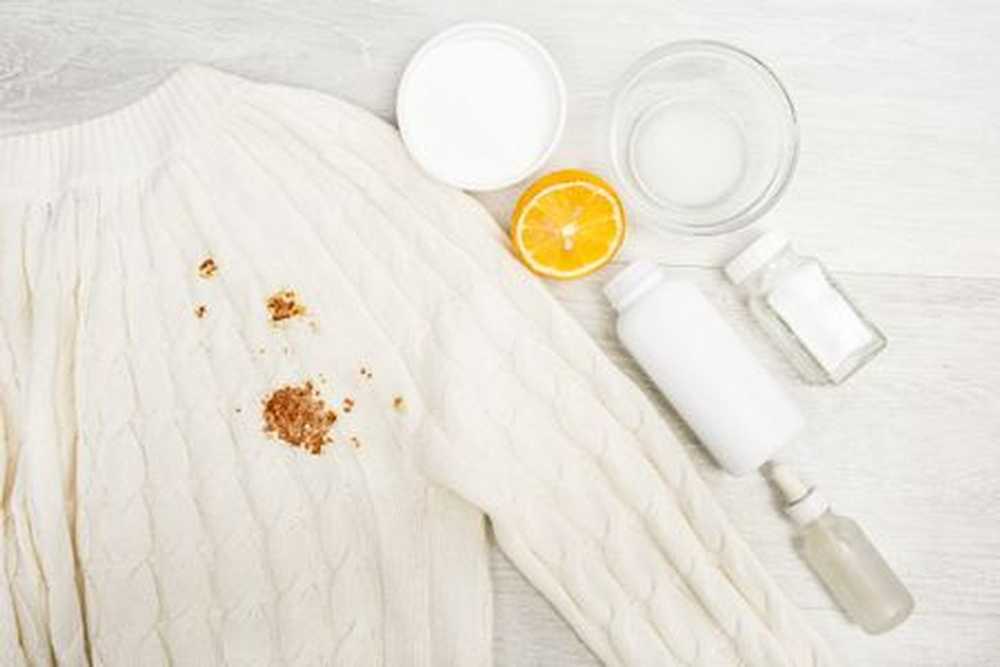Feeding baby refrigerated breast milk
Tips for Freezing & Refrigerating Breast Milk
Log in | Register
Ages & Stages
Ages & Stages
By: Dina DiMaggio, MD, FAAP
When it comes to breast milk, how you store it depends on how soon you want to use it.
Here are some helpful guidelines for storing your breast milk safely.
Before expressing or pumping: Wash your hands and all storage containers thoroughly. Label the date the breast milk was expressed on each container and include your child's name if you are giving the milk to a child care provider. Talk with your child care provider about how they require breast milk be stored and labeled.
Store breast milk in small batches. 2 to 4 ounces is recommended to prevent waste.
Any remaining breast milk left in a bottle after your baby is finished with a feeding should be used within 2 hours, or, if quickly refrigerated, used for the next feeding. You can always thaw an extra container if needed.
Refrigerate or chill milk right after it is expressed. Freshly expressed milk can remain at room temperature (up to 77°F or 25°C) for 4 hours (or up to 6 to 8 hours if very cleanly expressed), but it is best to chill as soon as possible.
Breast milk can be placed in the back of the refrigerator (39°F or 4°C). It is best to use refrigerated breast milk within 4 days, but it can be refrigerated for up to 8 days.
To warm breast milk from the refrigerator: Place the bottle in a bowl of warm water or run it under warm water. Microwaving breast milk is not safe due to the risk of scalding your baby with hot milk.
Freeze breast milk if you will not be using it within 24 hours.
 Breast milk expands as it freezes, so do not fill the milk all the way to the top of the storage container. Again store the milk in the back of the freezer, not the door.
Breast milk expands as it freezes, so do not fill the milk all the way to the top of the storage container. Again store the milk in the back of the freezer, not the door.If freezing the milk inside a refrigerator with a freezer that has a separate door (0°F or −18°C), milk may be frozen for up to 9 months.
If the freezer is a chest or a deep freezer (−4°F or −20°C), milk may be frozen for up to 12 months.
To thaw breast milk from the freezer: Put the bottle or bag in the refrigerator overnight, hold it under warm running water, or set it in a container of warm water. Remember that heating breast milk in microwaves is not safe.
Once breast milk is thawed: It can be stored in a refrigerator and must be used within 24 hours.
The Rule of 4's
We know breast milk storage can be confusing, so here is a more conservative approach that you can also go by (and easily remember): 4 hours at room temperature and 4 days in the refrigerator!
Editor's Note: Although these breast milk storage guidelines are appropriate for babies born premature and those who are hospitalized, hospitals may have their own rules. If you have specific questions, discuss these guidelines with your baby's pediatrician and/or hospital.
If you have specific questions, discuss these guidelines with your baby's pediatrician and/or hospital.
Where We Stand:
The American Academy of Pediatrics recommends breastfeeding as the sole source of nutrition for your baby for about 6 months. When you add solid foods to your baby's diet, continue breastfeeding until at least 12 months. You can continue to breastfeed after 12 months if you and your baby desire.
Additional Information & Resources:
- Expressing Breastmilk On the Job
Breastfeeding and the Use of Human Milk (AAP Policy Statement)
Effects of Extended Freezer Storage on the Integrity of Human Milk (The Journal of Pediatrics)
About Dr. DiMaggio:
Dina DiMaggio, MD, FAAP, is a board certified pediatrician at Pediatric Associates of NYC and at NYU Langone Medical Center. She is the co-author of
The Pediatrician's Guide to Feeding Babies and Toddlers, a comprehensive manual written by a team of medical, nutrition, and culinary experts. Follow her on Instagram
@Pediatriciansguide.
She is the co-author of
The Pediatrician's Guide to Feeding Babies and Toddlers, a comprehensive manual written by a team of medical, nutrition, and culinary experts. Follow her on Instagram
@Pediatriciansguide.
- Author
- Dina DiMaggio, MD, FAAP
- Last Updated
- 9/9/2016
- Source
- American Academy of Pediatrics (Copyright © 2016)
The information contained on this Web site should not be used as a substitute for the medical care and advice of your pediatrician. There may be variations in treatment that your pediatrician may recommend based on individual facts and circumstances.
Follow Us
Back to Top
Save or Dump: Can I Feed My Baby This Breast Milk?
Need ALL the tips and tricks, right now? Use EP15 for 15% off! Shop Now
Home » Bottle Feeding Breast Milk » Save or Dump: Can I Feed My Baby This Breast Milk?
Created On:  | Updated: | By Amanda | 89 Comments
In some scenarios, it’s not always clear whether breast milk is safe to give to your baby or needs to be discarded. Here are the most common “can I feed my baby this breast milk” questions, and answers according to the available guidelines and information.
Here are the most common “can I feed my baby this breast milk” questions, and answers according to the available guidelines and information.
This post may contain affiliate links, which means that if you click a link and take action, I may make a small commission at no additional cost to you. I only recommend products I love! More info here.
My baby didn’t finish a bottle. Can I reuse it and offer the bottle later?
If my baby drank some breast milk but didn’t finish the bottle, can I feed the leftover milk later?
Yes. You can offer it again within two hours.
Per the CDC, the guideline that we should follow is:
If your baby did not finish the bottle, the leftover breast milk can still be used within two hours after the baby is finished feeding. After 2 hours, leftover breast milk should be discarded.
What’s the reasoning behind this guideline? When your baby begins drinking from a bottle, there will be some bacterial contamination that occurs in the breast milk.
How quickly this will make the breast milk unsafe to consume depends on the room temperature, how long the milk has been stored, and the bacteria present.
As a general guideline (without knowing the individual circumstances of each bottle) the CDC states that offering again within two hours should be safe for consumption. After that, it may not be, and so should be discarded.
If I warmed a bottle and baby didn’t drink from it, can I put it back in the fridge? How long does breast milk last after warming?
If I warmed a bottle of breast milk and my baby didn’t drink any (she went back to sleep), can I put it back in the refrigerator and offer it again?
Yes. You can offer it again within the next two hours.
Per the CDC:
Once breast milk is brought to room temperature or warmed after storing in the refrigerator or freezer, it should be used within 2 hours.
The reasoning here is that bacteria starts to grow more quickly when the milk is warmed.
Can you reheat a bottle of breast milk?
If I’m reusing a bottle within the two hours, should I put it back in the fridge and rewarm it, or just leave it at room temperature?
Either rewarming or leaving it at room temperature is fine – whichever works best for you. Per Kellymom:
If you do save the milk for later use, some mothers re-refrigerate the milk and others leave it at room temperature – no studies have been done, so we don’t know whether one method is preferred. We do know that for any food, refrigeration slows bacteria growth. Milk storage guidelines do not include any warnings against rewarming milk, and many moms rewarm with no issues.
Just be sure to use or discard within two hours of the first warming.
Can I refreeze frozen breast milk?
My milk thawed in a power outage. I’m heartbroken! Can I refreeze it?
This is the worst feeling – I’ve had all my milk thaw due to one of my older kids unplugging my deep freezer.
But unfortunately, you cannot refreeze thawed breast milk, and you need to use it within 24 hours of when it has finished thawing (not from when the power outage started or you took it out of the freezer).
One important thing to note when considering this is that “finished thawing” means that all of the ice crystals are gone. If your breast milk still has ice crystals, it is considered safe to put back in the freezer.
Can I take breast milk out of the fridge and let it come to room temperature?
Can I take my breast milk out of the refrigerator and let it gradually warm up, instead of using a bottle warmer?
Yes, you can. However, there is a time limit on how long you can leave it out.
Again, per the CDC:
Once breast milk is brought to room temperature or warmed after storing in the refrigerator or freezer, it should be used within 2 hours.
So you have two hours once your milk comes to room temperature to feed it to your baby. How long does it take breast milk to come to room temperature when sitting out? I love experiments, so I tested it out.
How long does it take breast milk to come to room temperature when sitting out? I love experiments, so I tested it out.
It took about two hours when I tested it out (room temperature in my Chicago-in-January house was 66 degrees).
How long it will take your breast milk to warm to room temperature will depend on how much milk is in the bottle, what the ambient temperature is, and the composition of the milk. However, I think two hours is a good general guideline.
Can I leave refrigerated breast milk out, and feed it to baby in the middle of the night?
In the past, you’ve recommended letting freshly pumped milk sit out until baby’s first nighttime feeding (within 4-8 hours*). Can I do this with previously refrigerated milk, or does it have to be freshly pumped?
You can, as long as the feeding occurs with four hours – two for it to come to room temperature, and the two that it can sit out according to the CDC guideline discussed above.![]()
So, if your baby goes to bed at 8pm, you take the milk out and go to bed at 11pm, and your baby normally wakes up for a feeding before 3am, that will work fine.
*Note: The guidelines on how long freshly pumped breast milk can be safely left out at room temperature vary. The CDC says 4 hours is the maximum; Kellymom says 4-8, with 3-4 being ideal.
Can I take thawed breast milk out of the fridge and let it come to room temperature?
I’ve weaned from the pump and am feeding my baby from my freezer stash. I want to take some breast milk with me on an outing with my baby. I know I can’t thaw the milk at room temperature. But can I thaw it, and then let previously frozen milk come to room temperature in a my diaper bag before feeding it?
I could not find a clear answer to this question.
There are two parts to the question – a) can I let a bottle of previously frozen milk come to room temperature over time, and b) can I let a bottle of previously frozen breast milk sit out at room temperature until baby is ready to drink it?
We have to answer to the second part of the question from the Department of Health and Human Services:
Once breastmilk is thawed to room temperature or warmed after being in the refrigerator or freezer, use it within 2 hours.

So yes, a bottle of previously frozen breast milk can sit at room temperature for 2 hours.
However, they do not specify how the breast milk must get to room temperature. We know that we can’t thaw milk at room temperature (it needs to be done in the refrigerator or in water), but after it’s thawed, can it sit at room temperature to warm, or does it need to be warmed to room temperature by putting it in a bowl of lukewarm water? I read through a lot of documentation, and was not able to find an answer.
So, if you want to be on the safe side, I would recommend keeping the previously frozen milk cold in a cooler (more options here) and then warming it using one of the methods described here for warming breast milk outside the house.
What “can I feed my baby this breast milk” questions do you have that I missed? Share them in the comments, and I’ll try to find the answer!
Want help putting together the perfect pumping schedule for you that saves your sanity AND your milk supply? Check out the Exclusive Pumping Playbook! Includes cheat sheets for setting up systems and routines to make things easier.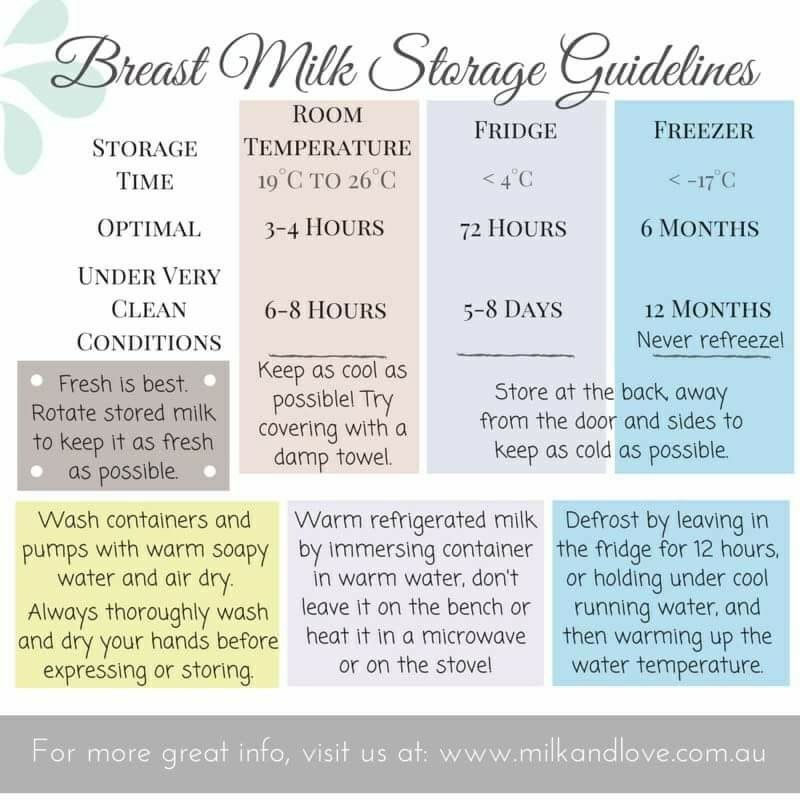 Use EPUMP30 for 30% off.
Use EPUMP30 for 30% off.
References
- Bonyata, Kelly. “Breastmilk Storage & Handling.” https://kellymom.com/bf/pumpingmoms/milkstorage/milkstorage/
- Bonyata, Kelly. “My power went out and I have breastmilk in the freezer – Help!” https://kellymom.com/hot-topics/frozen-milk-power-outage/
- Bonyata, Kelly. “Reusing Expressing Breast Milk.” https://kellymom.com/bf/pumpingmoms/milkstorage/reusing-expressedmilk/
- CDC. “Proper Storage and Preparation of Breast Milk.” https://www.cdc.gov/breastfeeding/recommendations/handling_breastmilk.htm
- Department of Health and Human Services. “Pumping and storing breastmilk.” https://www.womenshealth.gov/breastfeeding/pumping-and-storing-breastmilk
- Englash, Anne, and Simon, Liliana. “ABM Clinical Protocol #8: Human Milk Storage Information for Home Use for Full-Term Infants, Revised 2017. https://abm.memberclicks.net/assets/DOCUMENTS/PROTOCOLS/8-human-milk-storage-protocol-english.
 pdf
pdf
posted in: Bottle Feeding Breast Milk
Featured on:
As am Amazon associate I earn from qualifying purchases.
Storing, freezing and thawing breast milk
Expressed breast milk is the best food for your baby when you are not around. How to store and use breast milk correctly?
Share this information
If you go to work, go to the gym or simply ask your partner to feed your baby and you want to get some sleep yourself, you can express breast milk so that the baby can eat even when you are not around. Most of the beneficial properties are retained in expressed breast milk, so if you are forced to skip breastfeeding, it will be a better replacement than any formula. But an important guarantee of the safety of expressed milk for your baby is hygiene. Read the article to learn how to properly store breast milk.
What is the best way to store breast milk?
Any type of breast milk is better for the baby than formula. But freshly expressed breast milk is better than chilled, and chilled breast milk is better than frozen. The fact is that freshly expressed milk fights bacteria better, it contains more antioxidants, vitamins and fats than chilled or frozen milk 4 .
But freshly expressed breast milk is better than chilled, and chilled breast milk is better than frozen. The fact is that freshly expressed milk fights bacteria better, it contains more antioxidants, vitamins and fats than chilled or frozen milk 4 .
How long expressed breast milk lasts
Once your breast milk is properly collected in a clean container, you can store it at room temperature, in the refrigerator or in the freezer, depending on how soon you plan to use it. Follow the guidelines below:
Recommendations for storing expressed breast milk (for feeding healthy term babies) 2, 3
| Storage | Room temperature | Refrigerator | Freezer | Pre-frozen |
| Safe shelf life | Up to four hours Up to six hours for milk expressed under extra clean conditions* | Up to three days Up to five days for milk expressed under extra clean conditions* | Up to six months Up to nine months for milk expressed under extra clean conditions* | Up to two hours at room temperature Up to 24 hours refrigerated Do not freeze again! |
. 0116 . These instructions for storing and thawing breast milk are guidelines only. For more information, contact a lactation consultant or healthcare professional.
0116 . These instructions for storing and thawing breast milk are guidelines only. For more information, contact a lactation consultant or healthcare professional.
If the baby is in the neonatal intensive care unit (NIU) or intensive care unit, stricter cleaning and storage guidelines may apply in accordance with the hospital's internal policies.
Before placing expressed milk in the refrigerator or freezer, be sure to mark the bottles or bags with the amount of milk and the date of expression. This will make it easier to manage your pumped milk supply.
Recommendations for feeding expressed breast milk
During storage, breast milk usually separates into layers and the fat (cream) it contains rises to the top. Shake the bottle lightly to mix the layers before giving it to your baby. Strong stirring and shaking can destroy some of the nutritional and protective components of breast milk 5 .
When a baby is fed expressed breast milk from a cup or bottle, bacteria from the mouth naturally enters the milk. Therefore, it is best to throw out all the unfinished milk one to two hours after the first feeding. In order to waste as little expressed milk as possible, it is best to store it in small portions and use just enough for one feeding 2 .
Therefore, it is best to throw out all the unfinished milk one to two hours after the first feeding. In order to waste as little expressed milk as possible, it is best to store it in small portions and use just enough for one feeding 2 .
How to Store Breast Milk in the Refrigerator
2, 3Follow the guidelines below to safely store expressed milk in the refrigerator.
- Refrigerate breast milk as soon as possible after pumping.
- Store milk in clean BPA-free breast milk bottles or breast milk storage bags. Its long-term effects on the human body are not well understood and manufacturers are now moving away from the use of this chemical in plastic containers and coatings.
- After pre-cooling, a small amount of expressed milk can be added to the milk container stored in the refrigerator. Do not add warm breast milk to already chilled milk.
- Store breast milk in the coldest part of the refrigerator, on the back of the shelf above the vegetable drawer.
 Do not store milk in the refrigerator door where the temperature is not as constant.
Do not store milk in the refrigerator door where the temperature is not as constant.
How to store breast milk in the freezer
2, 3The following are recommendations for the safe freezing of breast milk.
- Freeze breast milk as soon as possible after pumping.
- After pre-cooling, expressed milk can be added to a container of already frozen milk. Do not add warm breast milk to already frozen milk.
- To simplify defrosting and reduce waste, store milk in small portions (less than 60 ml). Once thawed, portions can be mixed.
- Make sure the breast milk container is suitable for freezing: some containers (eg glass bottles) may burst at low temperatures. Medela Breast Milk Storage Bags are ideal for storing frozen breast milk: they are ready to use, cold-resistant and easy to label.
- Do not fill bottles or bags more than 3/4 full as milk expands when frozen.
- Store frozen breast milk in the back of the freezer where the temperature is constant.
 Do not place it against the walls of freezers with automatic defrosting.
Do not place it against the walls of freezers with automatic defrosting.
Feeding frozen breast milk
2, 3Follow these guidelines when thawing breast milk to keep it safe for your baby.
- Breast milk can be thawed in the refrigerator, usually takes about 12 hours. You can place the bottle or bag of frozen milk under running warm water (max. 37 °C). Do not thaw breast milk at room temperature.
- Fully thawed breast milk can be stored for up to two hours at room temperature and up to 24 hours in the refrigerator.
- Do not thaw or reheat frozen breast milk in a microwave oven or in boiling water. This can negatively affect the nutritional and protective properties of breast milk, and due to uneven heating, the baby can burn.
- If, after defrosting, you left breast milk at room temperature, but did not feed it to the baby within two hours, the milk must be discarded.
- Do not refreeze breast milk.
How to warm up expressed breast milk
2, 3 Healthy full-term babies can be given breast milk at room temperature or heated to body temperature.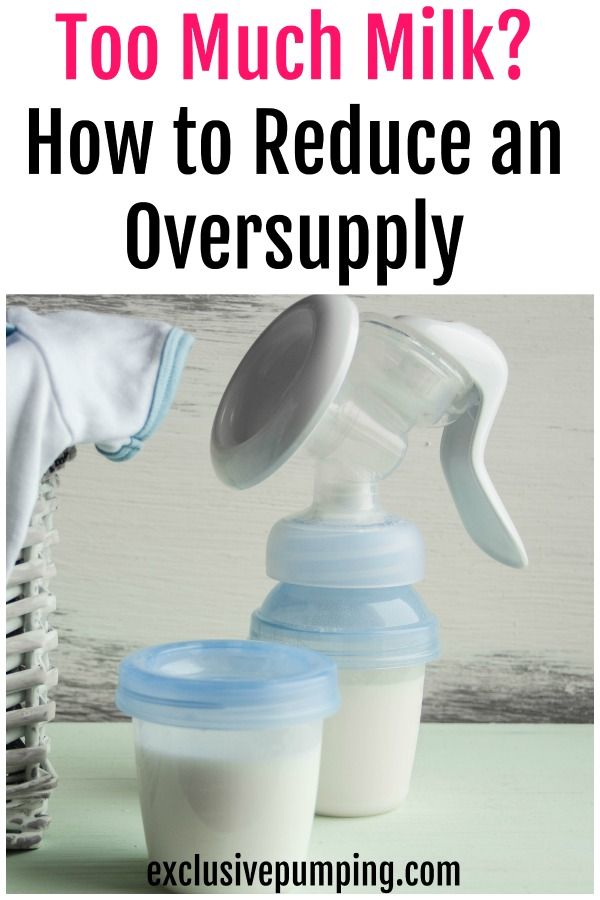 Some children care about the temperature of the milk, while others drink milk at any temperature.
Some children care about the temperature of the milk, while others drink milk at any temperature.
- To warm breast milk, place the bottle or bag in a cup, mug or bowl of warm water for a few minutes until the milk is at body temperature (37°C). You can use a bottle warmer. Do not heat milk above 40°C or microwave it to avoid overheating.
- Slightly shake the milk in the bottle or bag to mix the separated fat (see above). Do not stir or shake the milk too hard.
Why does milk smell strange after storage?
Chilled or thawed breast milk may smell different from fresh
. This is due to the action of lipase, an enzyme that breaks down fats into fatty acids, preventing the growth of dangerous bacteria.
Some mothers report that their milk smells rancid or soapy after storage. But if you followed all the recommendations for safe storage given in this article, such milk is absolutely safe 2 .
Storing breastmilk on the go
If you need to transport your breastmilk from work to home or nursery, use the cool bag with ice packs 2 .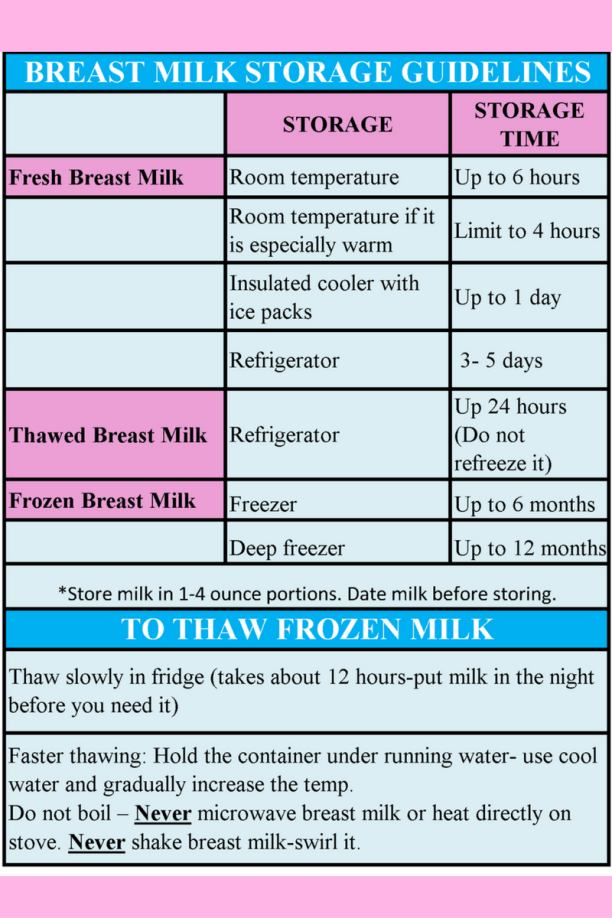 For more information on pumping and storing breastmilk on the go, see the article on pumping on the go.
For more information on pumping and storing breastmilk on the go, see the article on pumping on the go.
Literature
1 US Food & Drug Administration. Using a breast pump. [Internet]. Silver Spring, MD, USA: US Department of Health and Human Services; 2018 [updated 2018 Feb 04; cited 2018 Apr 12] Available from: 9US Food and Drug Administration "Instructions for using the breast pump". [Internet] Silver Spring, MD, USA: Department of Health and Human Services; 2018 [updated February 4, 2018; cited April 12, 2018] Article referenced: www.fda.gov/MedicalDevices/ProductsandMedicalProcedures/HomeHealthandConsumer/ConsumerProducts/BreastPumps/ucm061944.htm
3 Eglash,A., Simon,L., & The Academy of Breastfeeding Medicine. ABM clinical protocol #8: human milk storage information for home use for full-term infants, revised 2017. Breastfeed Med 12, (2017). - Eglash A, Simon L and Academy of Breastfeeding Medicine, AVM Clinical Protocol #8: Home Storage of Milk for Term Infants 2017 Revision. Brestfeed Med (Breastfeeding Medicine) 12 (2917).
Brestfeed Med (Breastfeeding Medicine) 12 (2917).
4 Human Milk Banking Association of North America. 2011 Best practice for expressing, storing and handling human milk in hospitals, homes, and child care settings. (HMBANA, Fort Worth, 2011).- North American Breast Milk Banks Association. Fort Worth: SABGM; 2011.
5 García-Lara NR et al. Effect of freezing time on macronutrients and energy content of breastmilk. Breastfeeding Medicine. 2012;7(4):295-301. - Garcia-Lara N.R. et al., "Effects of Freezing Time on Macronutrients and Calorie Content of Breast Milk". Brestfeeding Honey (Breastfeeding Medicine) . 2012;7(4):295-301.
6 Office on Women’s Health. Pumping and storing breastmilk. [Internet]. Silver Spring, MD, USA: US Department of Health and Human Services; 2018[updated 2018 Jan 12; cited 2018 Apr 12] Available from: www. womenshealth.gov/breastfeeding/pumping-and-storing-breastmilk
womenshealth.gov/breastfeeding/pumping-and-storing-breastmilk
7 Office of Women's Health, "Pumping and Storing Breast Milk" [Internet]. Silver Spring, MD, USA: US Department of Health and Human Services, 2018 [updated January 12, 2018; cited April 12, 2018] Article Link: www.womenshealth.gov/breastfeeding/pumping-and-storing-breastmilk
How to freeze breast milk and store it properly
While your baby is breastfeeding, it is recommended to feed on demand. On average, the baby eats every 2-4 hours. But this does not mean at all that a nursing mother should not leave the house for any business for a period of time longer than the breaks between feedings. It is quite possible to feed the baby with expressed breast milk one or more times. This product is much better than any, even the most expensive substitutes.
Therefore, if a breastfeeding mother has the opportunity to freeze breast milk in advance, it is necessary to gradually create a milk “bank”. Subsequently, it can be used to feed a child in the absence of a mother, having previously thawed the milk correctly.
Subsequently, it can be used to feed a child in the absence of a mother, having previously thawed the milk correctly.
Can breast milk be frozen?
If the choice is between a expressed product (which has been frozen) or a substitute (milk formula), the baby will definitely benefit from its own mother's milk. It retains most of all the nutritional components necessary for the baby, vitamins and microelements, immune factors. If the pumping procedure followed by freezing of breast milk is carried out correctly, the product will not deteriorate.
How to collect milk correctly?
If you need to feed your baby 1-2 times while the woman is away from home, it is not necessary to freeze the collected milk. This product can be stored at room temperature (up to 4-6 hours if the ambient temperature is not higher than 25-26 °C) or refrigerator (up to 3 days). In addition, for one or two feedings, you can pre-store milk by hand expressing it.
But if you need regular feeding of the baby in the absence of the mother and you need to freeze breast milk, you should buy a breast pump - manual (with a piston) or automatic.![]() Before you pump, you need to prepare everything you need:
Before you pump, you need to prepare everything you need:
- if it is a manual pumping, you will need containers (pre-sterilized) and a towel to dry your hands, protect clothes from drops;
- if this is a breast pump, it must first be washed, dried and assembled according to the instructions, after thoroughly washing your hands with soap and water.
The algorithm for collecting breast milk is simple: before starting the procedure, you need to wash your hands and find a comfortable place where no one will disturb you throughout the session.
In what container should milk be stored?
Modern breast pumps are equipped with handy bottles for storing pre-collected breast milk. In addition, special sterile container bags with applied divisions and a zip fastener are used. If these are not containers from a breast pump or bags, it is worth considering some simple requirements for containers and utensils in which breast milk is planned to be stored./how-to-defrost-breast-milk-431752_V3-01-f85080184f374a759b2c1106681e7cce.png)
- Glassware should not be used: during freezing, it may burst, and when defrosted, some of the beneficial components of milk will remain on its walls.
- It is important not to use plastic containers or polycarbonate bottles, even if sterilized. The composition contains bisphenol A, a dangerous compound that passes into breast milk (and any other food) when heated. For any baby products, including expressed milk, you need to purchase a plastic container marked "BPA free", they do not contain a dangerous compound and will not harm children's health.
- When using reusable containers, each time they are empty, they must be thoroughly washed and sterilized.
- Bottles or other containers should not be filled completely, but three-quarters, because when freezing, the liquid expands, its volume becomes larger.
How to freeze expressed breast milk?
After the mother has decanted, fill the bottle or jar ¾ full, close the lid tightly.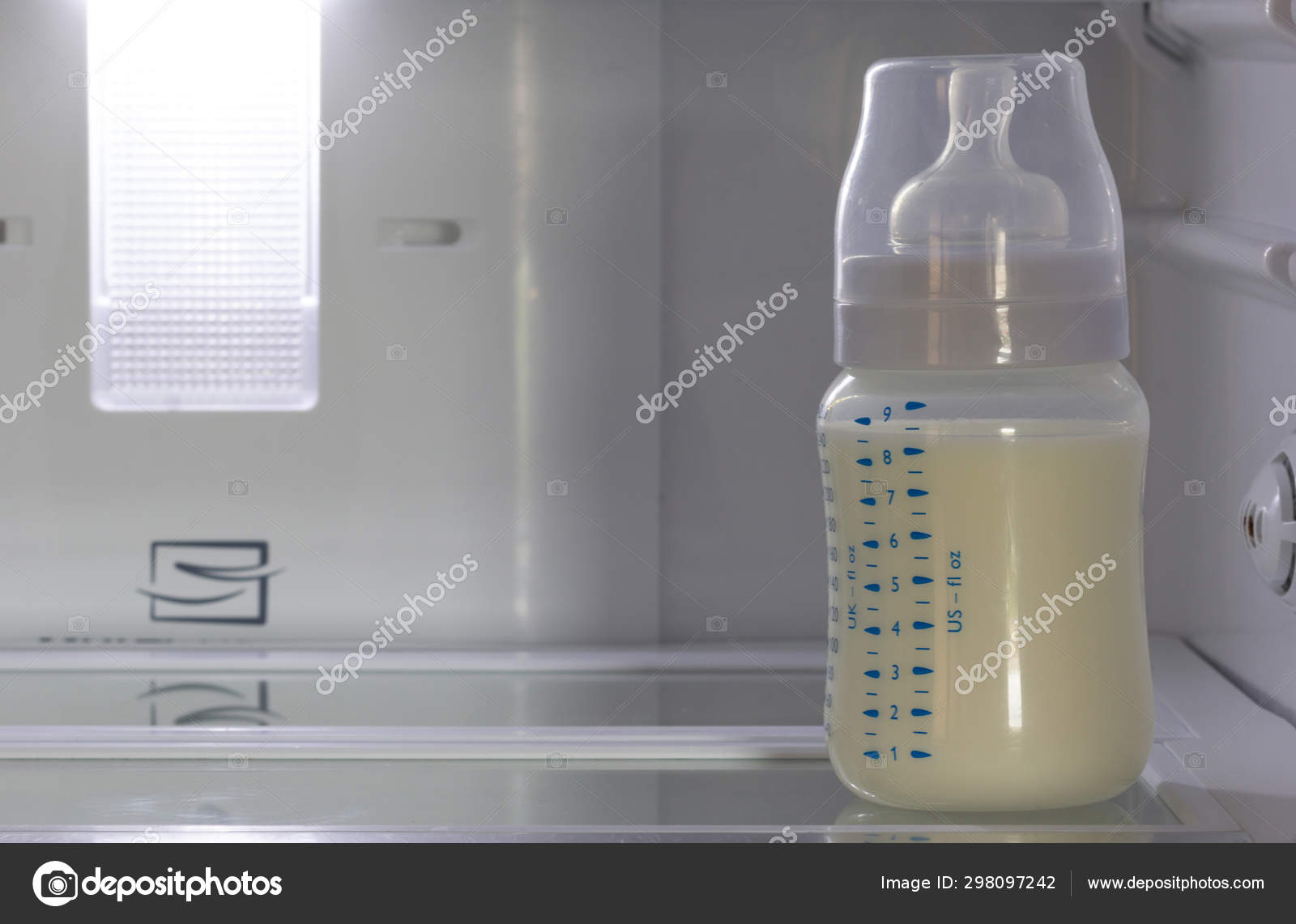 If it is a storage bag, it must be bled out of air before closing the zipper. On the container you need to stick a label on which the date and exact time of milk collection are indicated. Then all the containers must be cooled in the conditions of the refrigerator, and only then put into the freezer. Such a phased approach is necessary in order to preserve all the nutrients in the product, and the beneficial microflora does not die.
If it is a storage bag, it must be bled out of air before closing the zipper. On the container you need to stick a label on which the date and exact time of milk collection are indicated. Then all the containers must be cooled in the conditions of the refrigerator, and only then put into the freezer. Such a phased approach is necessary in order to preserve all the nutrients in the product, and the beneficial microflora does not die.
Ideally, portions of no more than 100-120 ml should be frozen, they can then be thawed and fully used for feeding or preparing complementary foods. If the child needs a larger portion, it is acceptable to defrost two packages and mix them.
It is permissible to add new portions of the expressed product to the frozen product, but it must first be cooled. The frozen portion should not be thawed. Warm, freshly obtained milk is not added to already frozen!
Another option is to collect chilled milk, periodically adding new expressed doses to the cooled one in the refrigerator, and then, when a full portion is collected, already to freeze.
Shelf life
The key to storage is maintaining a constant low temperature. To achieve this, it is recommended to place the product close to the rear wall of the chamber, as far as possible from the door. If it's an auto-defrost freezer, it's best to store the bags in the center of the freezer, avoiding the walls.
If you have a separate freezer that maintains a temperature of around minus 20°C, you can store milk supplies in it for 6-8 months, the maximum period is a maximum of 12 months. If it is a freezer inside the refrigerator with a separate door, the shelf life should not exceed 4-6 months. Do not freeze breast milk at temperatures below minus 25°C. This will negatively affect the beneficial microflora during subsequent defrosting.
How to defrost milk?
For maximum preservation of all nutritional properties, milk should be thawed gradually, without heating above 37-40 degrees. It is also desirable to refuse the use of a microwave oven, since it heats the product unevenly, and the beneficial substances are destroyed.



